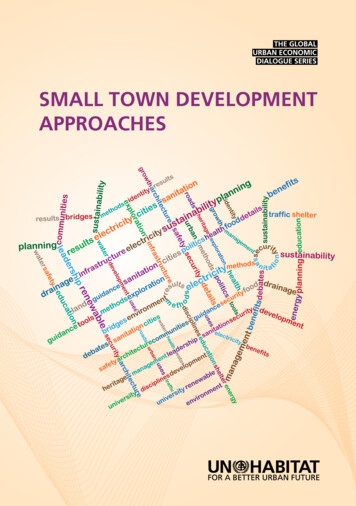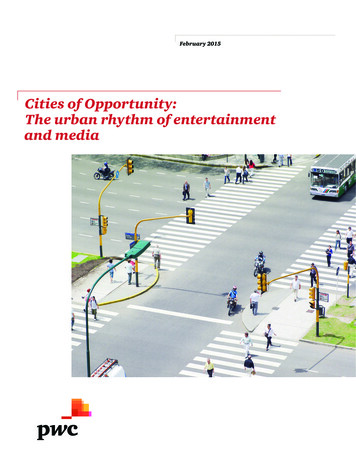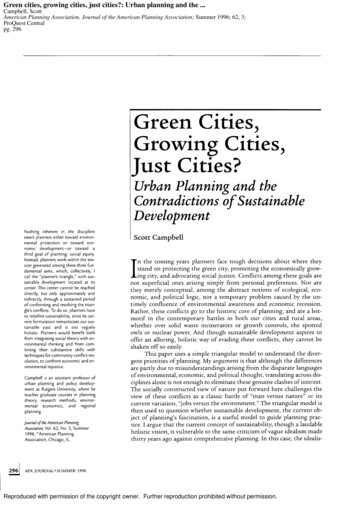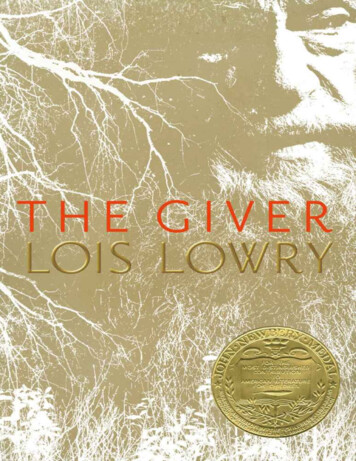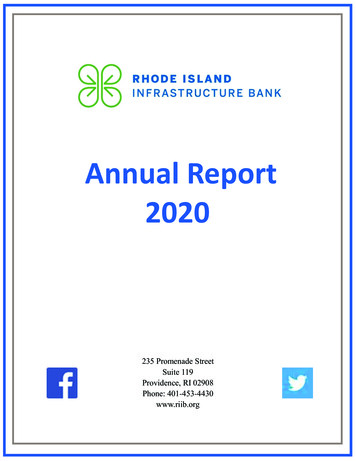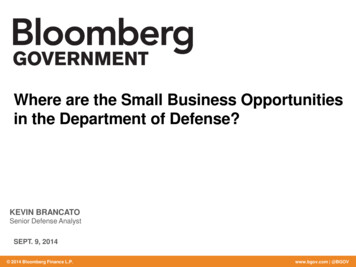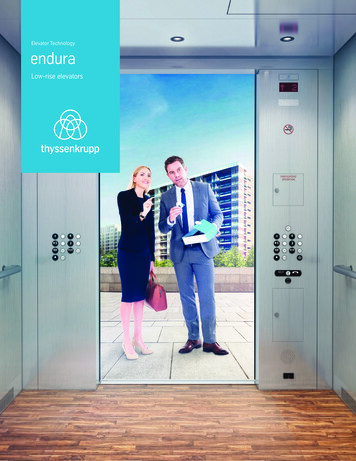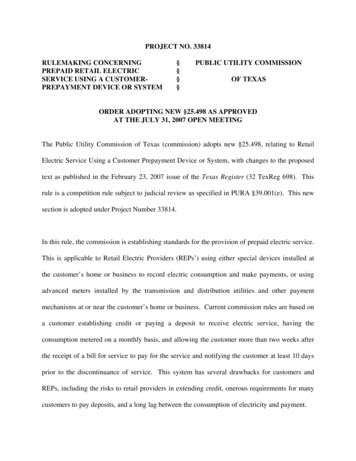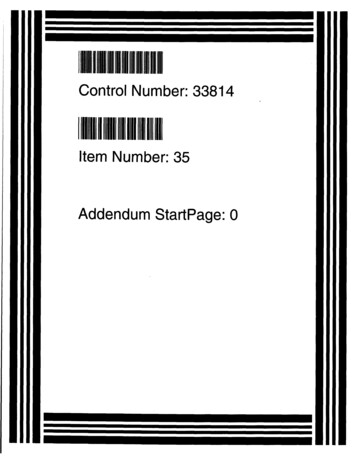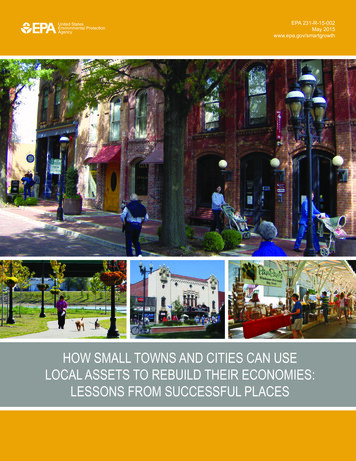
Transcription
United StatesEnvironmental ProtectionAgencyEPA 231-R-15-002May 2015www.epa.gov/smartgrowthHOW SMALL TOWNS AND CITIES CAN USELOCAL ASSETS TO REBUILD THEIR ECONOMIES:LESSONS FROM SUCCESSFUL PLACES
ACKNOWLEDGMENTSThis report was prepared by the U.S. Environmental Protection Agency’s (EPA) Office ofSustainable Communities with the assistance of CH2M Hill and Smart Growth America undercontract number EP-W-11-011.EPA project leads: Nora Johnson (ORISE Fellow), Adhir Kackar, and Melissa KramerIf you have questions about this publication, please contact:Melissa KramerOffice of Sustainable CommunitiesU.S. Environmental Protection Agency1200 Pennsylvania Ave. NW (MC 1807T)Washington, DC 20460Tel 202-564-8497kramer.melissa@epa.govReviewers from EPA: Stephanie Bertaina, Matt Dalbey, Linzy French, Megan Susman, and Kyle Theilacker, Officeof Sustainable CommunitiesRobin Jenkins and Patrick Walsh, National Center for Environmental EconomicsExternal reviewers: Chris Beck, U.S. Department of AgricultureDan Lurie, National Endowment for the ArtsMegan McConville, National Association of Development OrganizationsAden Van Noppen, White House Council on Strong Cities, Strong CommunitiesCover photo credits: Main photo: Paducah, Kentucky, courtesy of Calebism via Flickr.comBottom left photo: Dubuque, Iowa, courtesy of city of DubuqueBottom center photo: Emporia, Kansas, courtesy of Emporia Main StreetBottom right photo: Roanoke, Virginia, courtesy of St. Steele via Flickr.com
TABLE OF CONTENTSExecutive Summary . iI.Introduction . 1II.Bend, Oregon. 9III.Douglas, Georgia .13IV.Dubuque, Iowa .16V.Emporia, Kansas .21VI.Mount Morris, New York .24VII.Paducah, Kentucky .27VIII.Roanoke, Virginia .32IX.Conclusion.38
EXECUTIVE SUMMARYOver time, all communities experience changes that affect the industries, technologies, and land usepatterns that help form the foundation of their local economies. Economically resilient towns, cities,and regions adapt to changing conditions and even reinvent their economic bases if necessary. Evenif the community has lost its original or main economic driver, it has other assets that it can use tospur the local economy. While most economic development strategies involve some effort to recruitmajor employers, such as manufacturers or large retailers, many successful small towns and citiescomplement recruitment by emphasizing their existing assets and distinctive resources. This reportexamines case studies of small towns and cities that have successfully used this approach, including: Bend, Oregon (population 79,000).Douglas, Georgia (population 12,000).Dubuque, Iowa (population 58,000).Emporia, Kansas (population 25,000).Mount Morris, New York (population 2,900).Paducah, Kentucky (population 25,000).Roanoke, Virginia (population 98,000).While no magic bullet or set process will work everywhere, these case studies illustrate severalsuccessful tactics that other communities can use: Identify and build on existing assets. Identify the assets that offer the best opportunitiesfor growth and develop strategies to support them. Assets might include natural beauty andoutdoor recreation, historic downtowns, or arts and cultural institutions.Engage all members of the community to plan for the future. Engage residents,business owners, and other stakeholders to develop a vision for the community’s future.Stakeholder engagement helps ensure plans reflect the community’s desires, needs, and goalsand generates public support that can maintain momentum for implementing changesthrough election cycles and city staff turnover.Take advantage of outside funding. Even a small amount of outside funding appliedstrategically to support a community’s vision and plans can help increase local interest andcommitment in the area and spur private investment.Create incentives for redevelopment, and encourage investment in the community.Make it easier for interested businesses and developers to invest in the community in waysthat support the community’s long-term priorities.Encourage cooperation within the community and across the region. Cooperation toachieve jointly established priorities helps leverage the assets that each party can bring to thetable to make the most of the region’s resources.Support a clean and healthy environment. Invest in natural assets by protecting naturalresources and cleaning up and redeveloping polluted properties, which makes productive useof existing transportation, water, and utility infrastructure; increases the tax base andemployment opportunities; removes environmental contamination; and helps spur investmentin surrounding properties.i
I. INTRODUCTIONOver time, all communities experience changes that affect the industries, technologies, and land usepatterns that help form the foundation of their local economies. Economically resilient towns, cities,and regions adapt to changing conditions and even reinvent their economic bases if necessary.However, smaller communities often have a more difficult time making significant adjustments.They are more likely to depend on a single economic sector, and they might not have theinfrastructure, facilities, and human capital they need to tackle the complicated economic and socialchallenges they face. 1 As a result, many small towns and cities across the country have seen their jobbase shrink. Many residents move to other places with more opportunities, leaving behind thosewith few other options and concentrating poverty in struggling communities.Traditionally, manycommunities focus theireconomic developmentefforts on recruiting majoremployers such asmanufacturers or largeretailers. Many communitiesfocus on attracting clustersof related firms andinstitutions that can benefitfrom being close to eachother. While theserecruitment strategies canbring new jobs to acommunity, recruitmentoften simply moves jobsfrom one region to another,Exhibit 1. Locations of communities profiled. Communities across therather than creating newcountry are using local assets to rebuild their economies.jobs. Relying on recruitmentalone can be particularlychallenging for small towns and cities, because local governments often offer land, tax relief, andother incentives to attract employers. Small communities often are unable to offer the same level ofresources and incentives as larger cities, which makes it difficult for them to compete. 2While most economic development strategies involve some recruitment activities, many successfulsmall towns and cities complement recruitment by emphasizing their existing assets and distinctiveresources. Even if the community has lost its original or main economic driver, it has other assetsthat it can use to spur the local economy and rebuild its economic foundation. This report examinescase studies of small towns and cities that have successfully used this approach. The communitiesprofiled are:Pender, John, Alexander Marré, and Richard Reeder. Rural Wealth Creation Concepts, Strategies, and Measures. U.S.Department of Agriculture. 2012. research-report/err131.aspx.2 For a general discussion of these themes, see Fulton, William. Romancing The Smokestack: How Cities and States ShapeProsperity. Ventura, Ca.: Solimar Press, 2010.11
Bend, Oregon (population 79,000).Douglas, Georgia (population 12,000).Dubuque, Iowa (population 58,000).Emporia, Kansas (population 25,000).Mount Morris, New York (population 2,900).Paducah, Kentucky (population 25,000).Roanoke, Virginia (population 98,000).While no magic bullet or set process will work everywhere, these case studies illustrate severalsuccessful tactics that other communities can use:A.B.C.D.E.F.Identify and build on existing assets.Engage all members of the community to plan for the future.Take advantage of outside funding.Create incentives for redevelopment, and encourage investment in the community.Encourage cooperation within the community and across the region.Support a clean and healthy environment.A. Identify and Build on Existing AssetsCourtesy of steelman204 via flickr.comVirtually every community, regardless of size or circumstance, has assets that can be part of buildinga resilient economy. Successful communities identify the assets that offer the best opportunities forgrowth and develop strategies to support them. Assets might include natural beauty and outdoorrecreation, historic downtowns, or arts and cultural institutions. For example, Paducah, Kentucky,developed a cohesive identityaround its core assets of artisticand cultural offerings, the OhioRiver, and its rich history. Thecity provides financial andmarketing support for culturalinstitutions, such as a quiltmuseum and a performing artscenter, that draw activity andtourists downtown. Nonprofitarts and culture organizationsgenerated 39.9 million in localeconomic activity in the GreaterPaducah region in 2007 alone,Exhibit 2. Flood Wall in Paducah. The flood wall that protects historicsupporting 819 full-time jobsPaducah is covered with murals that depict scenes of important historicaland generating 3.6 million inmoments for the city.local and state governmentrevenue. 3Americans for the Arts. Arts & Economic Prosperity III. ucahKY FinalReportw03.pdf.32
Virtually every community began and grew because its location supported economic activity. Citieswere built to take advantage of natural resources and trade routes along rivers or othertransportation corridors. Many communities, especially small towns and cities, historically basedtheir economies on resource production and extraction with industries such as agriculture, mining,or timber. Some communities have recognized that conserving and restoring natural resources foroutdoor recreation and tourism can help build a stronger, more diverse economy. Both Roanoke,Virginia, and Bend, Oregon, have remade themselves as outdoor recreational destinations. Theyhave attracted new residents, visitors, and entrepreneurs, many of whom capitalize on their locationby starting related businesses such as manufacturing outdoor recreational equipment. Dubuque,Iowa, recognized that its river was central to its identity and that reconnecting the city’s residentswith this neglected natural asset could spark revitalization of the surrounding area.Courtesy of Emporia Main StreetHistoric downtowns are alsoimportant assets thatcommunities can use to helpspur their economies.Downtowns help define acommunity’s identitythrough distinctive, oftenhistoric architecture; shopsand restaurants; andcommunity gathering places.Maintaining the places andExhibit 3. Before (left) and after (right) renovation in Downtowninstitutions that make aEmporia. With the city’s encouragement, local businesses are adoptingcommunity specialdesign standards that help make the area appealing to shoppers.contributes to a sense ofplace and neighborhoodidentity, which help retain existing residents and could attract new residents and businesses.Virtually all the case study communities worked to revitalize and beautify their downtowns becausea downtown center of activity is an important part of the foundation of many local economies.Downtown revitalization strategies vary but include reducing vacancies, providing incentives to fixbuilding façades, improving streetscapes, and creating parks and greenways. Emporia, Kansas,created design guidelines for its downtown to promote development that contributes to thecommunity’s existing historic fabric and character. 4 Emporia also used the Main Street Four PointApproach, a preservation-based tool for economic development that has helped many small townsreap financial rewards by investing in revitalizing downtowns. 5Government agencies, private businesses, nonprofit organizations, and community institutions canalso be assets and core components of a local economy. In Roanoke, Virginia, Carilion HealthSystems, Virginia Tech, and the University of Virginia have made major investments to redevelopformer rail property adjacent to downtown, creating a new economic engine for the city. An assetmapping exercise can identify strengths the community can build on, assess their potential to catalyzedevelopment, and help develop and implement strategies to make the most of these assets. TheEmporia Main Street. Downtown Design Guidelines. 2008. ain%20Street%20Guidelines,%205-20-09.pdf.5 National Main Street Center. “The Main Street Four Point Approach.” -main-street/the-approach/. Accessed Mar. 4, 2015.43
Council on Competitiveness developed a guide to help leaders first identify human, capital,institutional, and intangible assets and then integrate them into a strategy for regional innovation. 6 Thisguide and other tools for community asset mapping 7 can be easily adapted for different areas of focusand geographic contexts.B. Engage All Members of the Community to Plan for the FutureIn 2005, Dubuque, Iowa,invested in a stakeholder-drivenplanning process to identify 10high-impact projects for the city.Tens of thousands of peoplesubmitted ideas, and communitymembers selected the projects.The community-driven processgave the ideas credibility amongdonors and residents. All of theprojects have been completed orare underway. Roanoke, Virginia,launched an extensive publicparticipation process in 2000 todevelop a vision for the future.Ultimately, Vision 2001-2020, thecity’s comprehensive plan, waspassed in 2001, incorporatinginput from a citizens’ advisoryCourtesy of EPACommunities that successfully retool their economies engage residents, business owners, and otherstakeholders to develop a vision for the community’s future. Stakeholder engagement helps ensurethat plans reflect the community’s desires, needs, and goals and generates public support that canmaintain momentum for implementing changes through election cycles and city staff turnover.None of the communities profiled here implemented all the changes overnight; a long-range plan isnecessary to guide work over many years. Planning often involves considerable effort coordinatingand integrating multiple processes to ensure they complement each other and work together toachieve the community’s goals. Comprehensive plans, area master plans, economic developmentplans, and other local and regional plans can help identify incremental steps that will move thecommunity forward.Exhibit 4. Historic Millwork District in Dubuque. Communitymembers identified restoration of the historic Millwork District as one of10 high-impact projects. Renovated warehouse buildings anchor theneighborhood and preserve a vital part of the city’s history and culture.Council on Competitiveness. Asset Mapping Roadmap: A Guide to Assessing Regional Development Resources. al-developmentresources/.7 U.S. Department of Housing and Urban Development. Connecting to Success: Neighborhood Networks Asset Mapping Guide.Undated. tsA/456E7EEFD772500C8525703F00614E6A/ File/assetmapping.pdf?OpenElement.64
committee, citizen-based task teams, city staff, consultants, the planning commission, city council,and the public. With the community-supported comprehensive plan to guide development decisions,the city could move forward with confidence. 8Planning is also an important, and often necessary, tool to help communities obtain funding forimplementation. Dubuque, Iowa, created a comprehensive plan in 1995 and has used it, along withplan updates in 2002 and 2007, to guide its redevelopment efforts. One of these efforts was a planto transform the Mississippi riverfront into a walkable, mixed-use neighborhood. Having a cohesivevision for the area helped raise the 188 million needed for the 90-acre riverfront revitalizationproject from city, state, and federal sources; the Dubuque County Historical Society; and privateinvestment. 9While philanthropic, federal, and state funding isimportant to communities of all sizes, it isparticularly helpful to smaller communities thathave limited resources to deal with challenges suchas out-of-date infrastructure, vacant and possiblycontaminated properties, and relatively fewamenities to attract new residents and businesses.Even a small amount of outside money appliedstrategically to support a community’s vision andplans can help increase local interest andcommitment in the area and spur privateinvestment. For example, Douglas, Georgia,jumpstarted its downtown revitalization through astreetscape project funded in part by a federalTransportation Enhancements grant. MountMorris, New York, used a grant from the state’sMain Street Program to help restore downtownbuildings, which spurred additional privateinvestment. Roanoke, Virginia, used a stateprogram to designate an area as an EnterpriseZone, making new or expanding businesses in thatarea eligible for incentives including façade grants,tax exemptions, and fee waivers.Courtesy of Pubdob via Wikipedia CommonsC. Take Advantage of Outside FundingExhibit 5. New Family Theater in MountMorris. In 2010, Mount Morris received a 433,500 grant from Restore NY to preserve andrenovate the art deco façade and marquee of the1930s New Family Theater and repurpose thebuilding.Communities can also create their own financialincentive programs. Small public investments can be narrowly targeted to encourage privateproperty owners in particular areas to contribute their own resources, creating a cumulative effectthat is greater than the sum of its parts. For example, Douglas, Georgia, helped renovate 40 façadesCity of Dubuque. Masterpiece on the Mississippi: Application for Iowa Great Places. 2006. uque-gp.pdf.9 URS Corporation, Leland Consulting Group, and EDG, Ltd. Port of Dubuque Master Plan. City of Dubuque. ome/View/288.85
in its downtown by offering small façade-improvement grants to businesses spending an equalamount of their own money.D. Create Incentives for Redevelopment, and Encourage Investment inthe CommunityMany communities reinvent their economies by making it easier for interested businesses anddevelopers to invest in the community in ways that support the community’s long-term priorities.Tactics to facilitate private-sector investment include streamlining the development process,providing technical assistance, and creating informational guides.Town leaders in Emporia, Kansas, partnered with Emporia’s Main Street Program to create a “codeteam” that brings together code officials, firefighters, engineers, and zoning staff to meet with newor expanding business owners at the business site to clarify requirements expeditiously. To helpsmall businesses, Douglas, Georgia, created a guide for starting and growing a business that outlineslocal resources, permitting and zoning processes, tax policies, and steps to get business loans. 10 TheMount Morris, New York, downtown development program gave private developers an inventoryof all the downtown buildings with information that helped encourage private investment, includingphysical characteristics, rental rates, ownership, and identification of tax-delinquent properties andthose near foreclosure.Financial incentives can also help encourage redevelopment. Livingston County, New York, whereMount Morris is located, set up a program under which taxes on the improvements in a communitydefined redevelopment area gradually increase over a 12-year period, allowing time for developersand businesses working in struggling areas to generate enough activity to afford the higher tax bill. 11To revitalize a downtown neighborhood, leaders in Paducah, Kentucky, created a home purchaseprogram focused on building an artist community. The town bought vacant or foreclosed buildings,then sold them to artists for as little as 1. In the first five years of the program, the town spentabout 3 million, while the artists invested approximately 35 million. More than 100 artistseventually came to live and work in the neighborhood, which is now filled with galleries, shops, andrestaurants that attract visitors and residents. 12E. Encourage Cooperation Within the Community and Across the RegionMany of the communities profiled were successful in part because entities with different missionsworked together to make the city a better place to live and work. Cooperation within the communityand across the region to achieve jointly established priorities helps leverage the assets that each canbring to the table to make the most of the region’s resources. Conversely, counterproductivecompetition for limited resources can undermine a community’s or region’s attempt to generatedurable economic growth.Douglas-Coffee County Chamber and Economic Development Authority. A Helpful Guide to Starting and Growing aBusiness in Coffee County. Undated. df.11 Macaluso, Tim Louis. “Development: The Mt. Morris Miracle.” City Newspaper. Jul. 18, evelopment-the-mt-morris-miracle.12 Stodola, Sarah, “How to Save the Cities—Send in the Artists.” The Fiscal Times. Jun. 4, 6
Mount Morris, New York, has taken advantage of its proximity to the State University of New York(SUNY) Geneseo to enlist students’ help in its revitalization efforts. Students have been involved ineverything from beautification projects to publicity about community events. 13 A SUNY student fillsthe role of a Main Street manager and coordinates advertising and social media outreach for theMain Street businesses. The city of Roanoke and the Roanoke Redevelopment and HousingAuthority assembled 23 acres of former industrial properties; conducted environmental site testing;and improved public utilities, streets, and drainage. They then sold the land to Carilion HealthSystems, which partnered with Virginia Tech and the University of Virginia to establish the CarilionBiomedical Institute. 14 The city’s 20 million investment in the center has leveraged more than 10times that amount in private dollars over the course of a decade. 15,16F. Support a Clean and Healthy EnvironmentProtecting natural resources and reducing pollution are not only compatible with economicdevelopment but can also support economic revitalization. Communities that invest in their naturalassets by protecting natural resources can better attract and retain residents, tourists, and businesseswho value clean air and water and natural landscapes. Cleaning up and redeveloping pollutedproperties makes productive use of existing transportation, water, and utility infrastructure; increasesthe tax base and employment opportunities; removes environmental contamination; and helps spurinvestment in surrounding properties.Sustainable Dubuque makes sustainability the city’s top priority, establishing 12 sustainabilityprinciples that guide city operations and community development plans, including the city’scomprehensive plan, long-range transportation plan, and comprehensive economic developmentstrategy. 17 This vision helps the city meet its goal of creating a legacy for generations to comethrough economic prosperity, environmental protection, and cultural vibrancy. In Bend, Oregon, aproperty the city wanted to redevelop was contaminated with hazardous substances from petroleumstorage tanks, wood treatment, charcoal manufacturing, and other activities. 18 The state and the sitedeveloper remediated 19 the property. The resulting Old Mill District now includes recreationalactivities along and on the Deschutes River, as well as a variety of restaurants, shops, and artgalleries. Not only has the redevelopment cleaned up environmental contamination, the Old MillDistrict also created an economic engine for the region, employing 1,700 people just one year afteropening. 20 Roanoke, Virginia, is improving its natural and outdoor recreation assets through a multi13 Wadsworth, Louise, and Greg O’Connell. Downtown Revitalization in Rural New York State. Livingston CountyDevelopment Corporation. 2011.14 Virginia Tech. “Carilion, Virginia Tech, U.Va. create biomedical institute – Virginia Tech Forms Optical Sciences andEngineering Research Center.” ScienceBlog. Nov. 18, 1999. /199904502.html.15 EPA. “Land Revitalization Spring '08 Newsletter – Roanoke’s Industrial Core Gets Economic Transplant AsBiotechnology Hub.” Fall/roanokesindustrial.html. AccessedFeb. 25, 2015.16 City of Roanoke. “Riverside Center.” aseLink/N27PEMWV328BTFKEN. Accessed Jun. 26, 2014.17 City of Dubuque. A Guide to the Dubuque Comprehensive Plan. 2007. 84.18 City of Bend. Bend Area General Plan. 2005. http://www.bend.or.us/index.aspx?page 634.19 Brownfield remediation is the removal or sealing off of a hazardous contaminant so that a site can be safely usedagain.20 EPA. Revitalizing Southeastern Communities: A Brownfields Toolkit. Undated.7
Courtesy of Roanoke Regional Partnership via flickr.compronged approach that includescreating a network of trails,improving facilities forbicycling, protecting scenic andecologically valuable land, andincreasing the treecanopy. 21,22,23,24 Since theseefforts began, tourism hasincreased, and in 2012, BlueRidge Outdoors Magazine namedRoanoke as the Best Mid-SizedMountain Town. 25The tactics all of these smalltowns are using support notjust economic development,Exhibit 6. Roanoke Go Outside Festival. An annual event to encouragehealthy, outdoor recreation brings community members together forbut also smart growth, anmusic, competitions, demonstrations, and outdoor gear sales.approach to communitydevelopment that protects theenvironment and public health, creates strong neighborhoods with diverse housing andtransportation options, and improves residents’ quality of life. Compact, diverse, and walkabledevelopment can increase property values and property tax revenues, encourage job creation, reducehousing and transportation costs, and create amenities and places that attract and retain residents.Real estate developers and investors, businesses, and local governments can therefore use smartgrowth development as a strategy to maximize their economic advantages. The connection betweensmart growth and economic success is explored in detail in a series of publications targeted towardthese audiences. 26City of Roanoke. “Bicycle Friendly Community.” BaseLink/N287YM9Q607LGONEN. Accessed Jun. 26, 2014.22 Roanoke Valley Area Metropolitan Planning Organization. Bikeway Plan for the Roanoke Valley Area Metropolitan PlanningOrganization 2012 Update. 2012. -BikewayPlan-2012Updateweb.pdf.23 City of Roanoke. “Conservation Easements.” BaseLink/N287YMAB696LGONEN. Accessed Jun. 26, 2014.24 City of Roanoke. “Tree Canopy.” BaseLink/N287YMEY344LGONEN. Accessed Jun. 26, 2014.25 Murray, Jack. “The Best Mid-Sized Mountain Town.” Blue Ridge Outdoors Magazine. Nov. 2012. he-best-mid-sized-mountain-town.26 EPA. Smart Growth and Economic Success: Benefits for Real Estate Developers, Investors, Businesses, and Local Governments. ers-investorsbusiness.218
II. BEND, OREGONBend, Oregon, in the central part of the state next to the CascadeMountains and Deschutes National Forest, draws visitors and newresidents with its scenic beauty and year-round outdoor recreation.Its population was 79,118 as of 2012, a more than 50 percentincrease since 2000, compared to the state’s roughly 15 percentincrease over that time. 27 Deschutes County, where Bend is located,led the state in population growth over the decade from 2000 to2010. The city began as a logging town at the turn of the 20thcentury, with lumber mills on both sides of the Deschutes River. Attheir peak, the mills employed more than 4,000 people and helpedBend become the world’s leader in the manufacture of secondarywood products. 28
Small communities often are unable to offer the same level of resources and incentives as larger cities, which makes it difficult for them to compete. 2. While most economic development strategies involve some recruitment activities, many successful small towns and cities complement recruit
